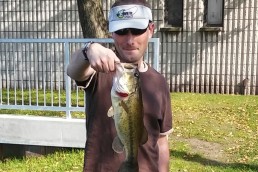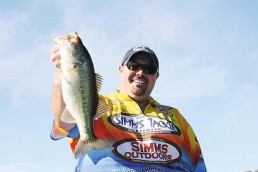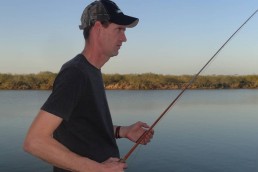Upper Midwest Largemouth Tactics
SHARE THIS POST
When it comes to big-largemouth angling in the Upper Midwest, many breakthroughs have shed light into their behavior. Knowledgeable bass fishermen in the northern states can catch this species consistently in the 3- to 5-pound range. But with a little more insight into big bass behavior, you can be on your way to catching that fish of a lifetime.
In terms of experience, a 2-year-old bass doesn’t necessarily behave like one that’s 3, nor does a 12-year-old bass share much in common with the smaller brethren, except around the spawn. With every pound a bass acquires, they become that much harder to catch.
These fish at the 5-pound weight class and above have had their share of experiences, and may have been fooled by a few lures. These have found consistent food sources and inhabit prime structures catering to the need for prey.
How do we know this?
Their sheer weight tells the tale.
After bass have spawned, and after they’ve readily gorged on prey, there is the temptation to throw a lure heavy on attracting qualities—a firetiger pattern in a crankbait—in order to get the fishes’ attention. This may be the antithesis of what that big bass will strike. An active juvenile bass will certainly hit a bright crankbait in relatively clear water, but a 5-pound-plus bass will seldom do so.
Going with more natural-toned lures and plastics may take some adjusting. The largemouth bass world is filled with them, consuming such natural offerings constantly. I am referencing crawfish, bluegills and other small fish, with bass being a generalist feeder. The qualities of plastic worms, craws, tubes, lizards and creatures remain hard for bigger bass to resist due to their realistic size or vibration, and visual lifelikeness. That is a solid list of appeals.
Are you enjoying this post?
You can be among the first to get the latest info on where to go, what to use and how to use it!
Compare the designs of Zoom Trick Worms, Berkley Power Grubs and Creme Scoundrel Worms. They have not changed much over a few decades, and are worth strong consideration. With new plastic creations, the ability to experiment is endless. On the hard bait end, a Shad Rap is a great year-round crankbait because they’re tight and have a natural wiggle. These lures also offer a great deal of baitfish patterns, such as perch, to tailor with your particular body of water.
Tournament angling dictates using lures high on attracting qualities (flash, bright coloration, rattles) found in your spinnerbait, crankbait and topwater assortments. In this arena the most pounds of fish wins, but in big-bass angling it’s a touch different—you just have to fool one lunker. That is not an overly complicated endeavor. Experiment with offerings with triggering qualities like natural shapes and tones or vibrations.
Here’s a list of strategies to hook more big bass.
- Start fishing the deeper drop-offs surrounded by dark-green, oxygen-rich weeds first. Avoid initial casting into shallow cover unless the depths don’t pay off. It’s tempting to work cover first, but a radical departure may be needed if we are not landing lunkers.
- Use plastic lures in sizes that reflect live forage.
- Stay natural or neutral, unless wind, deeper water or water clarity forces a change to the brighter offerings.
- Be open to spinning-rod presentations like finesse worming.
- On calm days, rig your plastic with little or no weight so there is barely a bow in the line when the lure hits the bottom. You will barely feel the rig as it is worked. This is called the “no-feel” technique. The slight slack line will lift when a bass strikes.
- Make sure your plastic bait flutters or wobbles as opposed to falling straight down. The more time a lure is in the strike zone the increased likelihood bass will strike.
- Use neutral green, brown, camo-toned monofilament or fluorocarbon-coated lines or leaders.
- Use your rod tip to impart the subtle twitches inherent in natural forage.
- Drag a bait on the bottom with the rod tip up, mimicking craws.
- Quick hops of plastic offerings created by upward rod jerks have netted some of my biggest fish in and around steep drop-offs.
- Fish as often as you can and get into your own groove. Big-bass angling is a mental game.
- Keep a log of your success. (Remember, the lunkers are extremely territorial.)
You probably have a pretty good idea of what types of lures, rods, reels and line you prefer to throw. Adapt slowly with experimentation around your favorite bread-and-butter techniques to watch the numbers of larger bass you catch skyrocket.
My three fundamentals for big bass presentations with lures are: plastics (weedless) around the steepest drop-offs adjacent to shallows and other structures; patience, which is the key on hot spots, as you almost cannot fish a worm too slow, but knowing where is important; and modern-angling intuition is pretty good, bearing in mind that hot spots deserve methodical fishing.
With all the good baits and lures in bass fishing, you will still have your own fundamentals developed in time. It could be a jig and pig, rattling crankbait or Carolina Rig lizard, but if one specific lure catches a lunker, work it repeatedly. Remember, a bass never thinks much about hitting your lure but is simply doing what it was programmed to do.
MWO
SHARE THIS POST
Did you enjoy this post?
You can be among the first to get the latest info on where to go, what to use and how to use it!
Frank Racz
With almost two decades of fishing retail knowledge, Frank Racz’s dedication to the “stitching technique” has led to a modern Midwestern largemouth bass variant and bluegill pursuits. He is avid about the techniques’ multispecies potential and other long spinning rod inquiries featured on his YouTube channel.



